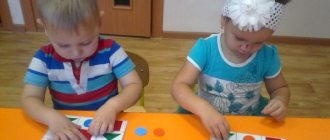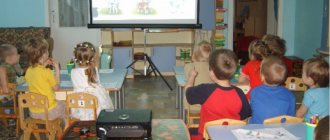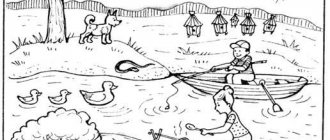Developing a child’s logical thinking is just as necessary as teaching new things, because knowledge is only tools, and logic is the ability to use them. Logic will teach you to analyze problems and situations, find and apply non-standard solutions. Such skills will be useful both in kindergarten and school, and in everyday life. There are many different exercises to develop logical thinking. But if your little one is tired of regular puzzles, offer him some fun math puzzles.
What are math puzzles?
These are entertaining tasks with game elements. Such tasks do not require deep mathematical knowledge and special training; rather, you will need intelligence and observation.
There are a lot of math puzzles. These include logical puzzles, problems with numbers and pictures, paradoxes and probabilities, and much more. They can be simple, which the child can easily cope with on his own, or complex, when he needs the help of his parents.
Development and education of children from 2 to 11 years old in a playful way
Start practicing right now
Start practicing
Math lesson notes “Addition and subtraction problems”
Lesson topic: Addition and subtraction problems.
Goals: • Teach children to compose addition and subtraction problems, formulate arithmetic operations; • Practice comparing adjacent numbers within 10, consolidate the idea of the sequence of numbers; • Teach children to solve problems using ingenuity (building figures made from sticks); • Develop the ability to plan the full or partial course of a solution; • Imagine the changes that will occur as a result of moving the sticks.
Objectives: • To consolidate the idea of geometric figures, the signs “greater than” and “less than”, to teach children to use them, to consolidate the idea of ordinal and backward counting, the use of numbers, the relationship of adjacent numbers, and the composition of a number from two smaller ones. • To develop in children the skills of learning activities, the desire to help a friend, and to participate in the implementation of a common goal.
Demonstrative material: a table depicting numbers from 1 to 10 in different sizes, a table depicting a plate with cuts on it, 7 color images of sweets; board, chalk
Handout: counting sticks.
Preliminary work: games “Name and Show”, “Shapoklyak’s Tricks”.
Methods and techniques: surprise moment, game techniques, clarifications, surveys.
Progress of the lesson
"Name and show"
Name and show the numbers from 1 to 10 and in reverse order from 10 to 1.
- What number goes up to 5? (4? 3? 2?) - What number comes after 7 (8? 9?) - Why does 7 come after 6? (3 after 2?) - Why does 8 come before 9? (6 to 7?)
The song Cheburashka from the cartoon “Cheburashka and Gena” is playing.
- Guys, do you hear someone singing? Who is this?
There's a knock on the door. The teacher opens the door, and there is Cheburashka Gena.
- Guys, look who came to visit us? Do you recognize them?
Cheburashka tells the children what happened to them.
"The Tricks of Shapoklyak"
Gena and Cheburashka traveled by train. At one of the stations, Shapoklyak decided to disrupt the trip and unhooked some of the trailers. What kind of trailers are these? Give their numbers.
Fizminutka
One two three four five. One two three four five! We all know how to count, we also know how to rest - we’ll put our hands behind our backs, we’ll raise our heads higher. And let's breathe easily. Pull yourself up on your toes as many times as there are fingers on your hand! One, two, three, four, five, stomp our feet. One, two, three, four, five, clap our hands. One two three four five. I add, I subtract, I know mathematics. And that’s why in the morning I shout: “Hurray! Hooray!"
- Guys, today we will not only create problems, but also learn to tell what needs to be done to solve it. And our guests Gena and Cheburashka will follow and also learn to solve problems. - Look how many sweets are in the plate. (“There are 6 candies in the plate”)—I will put 1 more candy in the plate. Make up a problem about what I did.
The called child tells the problem.
- What do we know? How many candies were there? How many candies did I put in? - Yes, we know this, this is the condition of the task. What don't we know? That's right, we don't know how many candies are in the plate - that's a question of the problem. What needs to be done to answer the problem question? “We know how many sweets there were, and since we know, why count them.” Are there more or fewer candies after I put 1 more candy on the plate? - That's right, there are more candies. To solve the problem, you need to add 1 to 6, you get 7. Can you now answer the question of the problem? Who will answer the task question? So what did we do to solve the problem? The teacher asks 2 children to repeat the solution to the problem. Guys, now we will not only answer the question of the problem, but also talk about what needs to be done to solve it. Let's solve one more problem. There were 7 candies in the plate, I gave 1 candy to Seryozha. Come up with a task. - What do we know? What don't we know? Was there more or less candy in the plate after I gave 1 apple to Seryozha? - That's right, there are fewer candies. To solve the problem, you need to subtract 1 from 7, you get 6. How many candies are left in the plate? What did we do to solve the problem?
"Name the shapes"
— Guys, name these geometric shapes. - Now, tell me, how many circles are there in the picture? (9) - How many ovals? (7) - How many triangles? (8) - How many squares? (8) - Which figures are there more? More than what figures? - Which figures are smaller? Smaller than which figures? - Which figures are equal?
"Task with sticks"
- Guys, count out 4 sticks and make a square out of them. - Now, think about which stick needs to be moved to another place to get a chair? - Count out 6 sticks and make a house out of them. Think about which 2 sticks need to be rearranged to make a flag. When you decide how to rearrange the sticks and imagine that you will get a flag, complete the task. — Guys, tell me the flag you got is similar to these flags. — What colors does the flag of Russia and Tatarstan consist of? Well done! - Come on, we’ll give our flags to our friends - Cheburashka and Gena. — Tell me, guys, did you like today’s lesson? What did you like?
Author: Nailya Nailevna Ramazanova, teacher, Child Development Center - Kindergarten No. 236, Kazan, Republic of Tatarstan
The article is published in the author's edition
Perform developmental exercises from Ikyusha
Mathematics
Reading
The world
Logics
English language
Puzzle “Card, please”
Look carefully at the credit card numbers. What three numbers should be written in place of the question? Already have any guesses?
We hope you completed the task quickly! And the next puzzle is already waiting for you.
Puzzle “Chairs”
The teacher asked the students to arrange 9 chairs along the four walls of the classroom so that each wall had three chairs. The students completed the task. Can you?
Puzzle “House number”
Hardworking builder Evgeniy arrived on site earlier than the others, but forgot the house number! We know that the house is located between plots 88 and 98. Can you help Evgeniy and tell him the number?
Bullseye Puzzle
Do you like to watch archery competitions? It's so exciting! Look, both archers have already performed, let's count how much archer B scored? We know that shooter A scored 54 points, and points are earned proportionally from the end: 1, 2, 3...
Puzzle “Mom and Daughter”
In this task you need to guess the ages of the mother and daughter. We know that if you add up their ages, you get the number 66. And if you swap the numbers of the mother’s age, you get the exact age of the daughter. Moreover, the mother is no older than 59, and the daughter is no younger than 7. Guess how old they are?
Puzzle “Hurray, fireworks!”
Look how beautiful the fireworks are! And not just one, but six! But one of them was not launched, determine which one?
Puzzle “Mathematics”
The task is simple - fill out each line and column so as to get the specified result at the end. You can only use numbers from 1 to 9 so that there are no repetitions in each line.
Puzzle “Wise Old Man”
The father of three sons made a will so that after his death the children would divide their father's herd of camels like this: the eldest son would take half, the middle son only a third, and the youngest son would get only a ninth. The father died, leaving a herd of 17 camels. Unable to divide the animals, the children asked the wise old man to help them. The elder agreed and, arriving on his camel, divided the animals according to his will. How did he do it?
This puzzle is a variation of Italian mathematician Niccolò Tartaglia's famous "Difficult Inheritance" problem. He went down in history as the scientist who discovered the solution to cubic equations.
Puzzle “Counting fruits”
Where else if not in a store to train counting skills? Let's buy 2 sweet aromatic oranges? How many coins will you need to pay for them? Look at the picture and count.
Logic puzzles for children 6–7 years old
Rechkina Luda
Logic puzzles for children 6–7 years old
1. You, me, me and you. How many of us are there in total? (2)
2. A man was walking into the city and on the way he caught up with three of his acquaintances. How many people went to the city? (4)
3. There were three apples in the vase. Mom treated them to three girls. Each of the girls received an apple, and there was one left. How did it happen? (one girl took an apple from a vase)
4. Three horses ran 5 km. How many kilometers did each horse run? (5 km each)
5. If a chicken stands on one leg, then it weighs 2 kg. How much will a chicken weigh if it stands on two legs (2kg)
6. Three brothers have one sister. How many children are there in the family ? (4)
7. You need to divide five apples between five girls so that one apple remains in the basket. (one must take an apple from the basket)
8. Can it rain for two days in a row? (night cannot, divides days)
9. There were four birch trees. Each birch tree has 4 large branches. On each large branch there are 4 small ones. There are 4 apples on each small branch. How many apples are there in total? (not a single one, apples don’t grow on birch trees)
10. There were 4 apples on the table. One was divided in half. How many apples are on the table? (4)
11. One person was asked. children does he have ? The answer was: “I have 6 sons, and each has a sister”
(7)
12. Which figure has neither beginning nor end? (at the circle)
13. How can you pick a branch without scaring a bird off it? (impossible, it will fly away)
14. There were three glasses with berries on the table. Vova ate one glass of berries and put it on the table. How many glasses are there on the table? (3)
15. Three candles were lit in the room. Then one of them was extinguished. How many candles are left? (one, two others burned down)
16. Three people waited for the train for three hours. How long did each person wait (3 hours)
17. Vova went to his grandmother on Monday, and returned on Monday next week. How many days later did he return? (7)
18. The boy and girl had the same number of nuts. The boy gave the girl 3 nuts. How many more nuts does the girl have than the boy? (by 3)
19. The first box contains 10 pencils, the second contains as many as the first, and the third contains the same as the second. How many pencils are in the third box? (10)
20. Sveta went to camp on Saturday. She promised her mother to come to her in 5 days. On what day of the week will mom come to Sveta? (Friday)
21. There was water in the decanter. When 5 glasses were poured out of it, one glass of water remained. How much water was in the decanter? (6 glasses)
22. Lesha had 4 red flags, he was given another blue flag. How many flags does Lesha have now? (5)
23. 6 birds were sitting on a tree. A hunter came and killed one bird. How many birds are left on the tree? (not a single one flew away, they were scared)
24. There was one candy in the vase. By evening she was gone. Who took it if there were a cat, fish in an aquarium, grandfather and a moth in the room? (grandfather)
25. If you eat one plum, what remains? (bone)
26. Two trains arrived in Moscow at the same time - fast and passenger. The passenger was driving slower. Which train left first? (passenger)
27.Birds flew across the sky: a sparrow, a dragonfly, a swallow and a bumblebee. How many birds were there in total? (2)
28. A squirrel threw a pine cone from the Christmas tree at the bear and hit him on the forehead. How many cones are there? (2)
29. Anya, Masha and Dasha live on different floors of a three-story building. On which floor does each girl live if it is known that Anya does not live on the second, Masha does not live on the second or third? (Masha on the first, Dasha on the second, Anya on the third)
30. Three boys walked along the road and found three rubles. How many would each of them find if he went alone? (3)
31. Three, three, three, three, three - what will happen? (hole)
32. Two friends played checkers for four hours. How many hours did each player play? (4)
33. There were 5 ducks swimming on the lake, the hunter shot and killed one. How many ducks are left? (none of them all flew away)
34. How many ears do three mice have? (6)
35. Only four logs can be loaded onto the machine. How many times do you need to go to the forest to remove nine logs? (3)
36. The heel had nine balls. Kanga came and took away four balls, then Tiny came and took away five balls. What's left for the heel? (0)
37. There were 10 chairs in the room on which 10 boys were sitting. 10 girls came in, and they all found a chair. How could this happen? (gave in)
38. Two friends came to Masha, and she had two apples. “Take,” says Masha, “a whole apple, and give me half.”
. Did Masha share honestly?
39. Along the path, 10 trees grow one after another, between which there are benches. How many benches are there in total? (9)
40. How many times must the bear cub cut the log so that he gets 4 logs? (3)
41. A grandmother was walking to Moscow, and three old men met her. Every old man has a bag, and every bag has a cat. How many living beings went to Moscow? (one grandma)
42. You are the pilot of an airplane flying from Paris to Moscow with a landing in Kyiv. Flight time is two hours. How old is the pilot? (how old are you if you are a pilot)
43. When the goat turns 6 years old, what will happen? (going to 7th year)
44. In a clearing by the river
May beetles lived
Daughter, son, father and mother
Who managed to count them? (4)
45. The starling laid one egg every day. How much did she lay in 7 days? (7)
46. Grandma Dasha has a granddaughter Masha, a cat Fluff, and a dog Druzhok. How many grandchildren does grandma have? (one granddaughter Masha)
.
47. There is a tub near the wall, and in that tub there is a frog. If there were 7 tubs, how many frogs would there be? (possibly none)
.
48. How to cut a square in order to add 2 new squares from the resulting parts?
49. Birds flew over the river: a pigeon, a pike, two tits, two swifts and five eels. How many birds? Answer quickly! (5, other fish)
.
50. 7 candles were burning, two candles went out. How many candles are left? (2, the rest burned)
.






